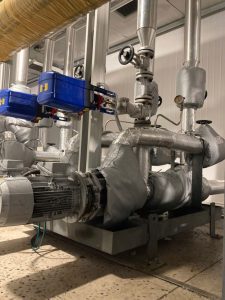Heat loss in a factory not only skyrockets energy bills but also poses risks to worker safety and reduces equipment lifespan. Regularly assessing insulation effectiveness is a strategic step for businesses to pinpoint “hot spots” causing waste, leading to optimal solutions like using removable insulation jackets for valves, flanges, and pipelines.
This article provides a comprehensive 5-step checklist to help technical teams conduct surveys methodically and effectively.
Why Do Businesses Need to Regularly Assess Insulation Effectiveness?
Ignoring uninsulated areas or those with degraded insulation can lead to several negative consequences:
- Energy Waste & Increased Costs: Heat lost through pipes, valves, and equipment surfaces forces the system to work harder to maintain the required temperature, directly increasing production costs and reducing profits.
- Workplace Safety Risks: High-temperature equipment surfaces (often above 60°C) can cause severe burns to workers upon accidental contact, violating current safety standards.
- Reduced Equipment Lifespan: Increased ambient temperatures due to heat loss can affect other machinery and electronic components, causing them to wear out and fail more quickly.
A systematic assessment process helps quantify these losses and builds a solid case for investing in efficiency improvement solutions.
A 5-Step Checklist for Assessing Insulation Effectiveness in Your Plant
To ensure the survey process is systematic and thorough, follow the 5-step procedure below.
Step 1: Preparation & Survey Planning
Thorough preparation is crucial to the success of the entire project.
- Define objectives: Clarify the main goal: Is it energy savings, enhanced safety, or both?
- Form a dedicated team: Assign personnel with expertise in energy, maintenance, and safety.
- Prepare tools:
- Thermal camera or infrared thermometer (a thermal camera is recommended for its ability to provide a comprehensive scan and quickly detect hot spots).
- Plant’s Piping and Instrumentation Diagram (P&ID).
- Data logging forms (for temperature, location, size).
- Full Personal Protective Equipment (PPE).
- Create a schedule: Choose a time when the system is operating under stable and typical conditions to ensure the collected data is as accurate as possible.
Step 2: On-Site Survey & Data Collection
This is the core phase for identifying problematic areas.
- Review the entire system: Walk along steam, hot water, thermal oil lines, boilers, and other heating equipment.
- Scan for “hot spots” with a thermal camera: Focus on uninsulated locations or areas where insulation is old, torn, or damaged. The most commonly overlooked spots include:
- Valves of all types
- Flanges
- Y-Strainers
- Steam Traps
- Expansion Joints
- Large equipment surfaces (boiler bodies, plastic injection machines, dryers…)
- Record and store information: Measure and log the surface temperature at identified hot spots. Take photos of the location, and note the equipment type, size, and operating conditions at the time of measurement.
Step 3: Data Analysis & Loss Estimation
The raw data collected needs to be analyzed to quantify losses and determine priorities.
- Categorize hot spots: Prioritize areas for action based on temperature differentials, safety risks, and potential energy savings.
- Calculate heat loss: Use specialized software or calculation formulas to estimate the amount of wasted thermal energy (BTU/hr or Watts) and convert it into annual energy cost losses.
- Compare with safety standards: Compare the measured surface temperatures with industrial safety standards (e.g., the US OSHA standard recommends that accessible surface temperatures should not exceed 140°F or 60°C).
Step 4: Propose Solutions & Calculate ROI
Based on the analysis, create a persuasive proposal report.
- Select appropriate solutions:
- For components with complex shapes (valves, flanges, elbows) or those requiring frequent removal for maintenance, removable insulation jackets (blankets) are the optimal solution.
- For straight pipe sections, traditional insulation materials can be used.
- Prepare an investment report: The report should clearly present:
- A list of areas needing improvement and the proposed solutions.
- Projected investment costs for materials and labor.
- Potential energy savings (kWh, tons of steam…) and their monetary value.
- Calculate the Return on Investment (ROI): This is the most critical financial metric to convince management for approval. Typically, projects involving insulation jackets have a very short payback period, often under 1-2 years.
Step 5: Implementation, Monitoring & Re-assessment
Once approved, the project must be implemented and closely monitored to ensure its effectiveness.
- Installation: Install insulation jackets and other insulation solutions according to the plan and technical standards.
- Post-implementation measurement: Use a thermal camera to re-measure surface temperatures at the treated locations. Compare the before and after results to confirm the project’s effectiveness.
- Establish a regular inspection cycle: Incorporate “hot spot hunting” into the plant’s routine maintenance schedule (e.g., every 6 or 12 months) to maintain long-term insulation efficiency and create a cycle of continuous improvement.
Frequently Asked Questions
What is a removable insulation jacket?
A removable insulation jacket is a flexible insulation solution, custom-designed for complex-shaped components like valves, flanges, and joints. They are easily removable for maintenance, helping to reduce heat loss and ensure safety.
Why is it necessary to conduct regular heat loss surveys?
Regular surveys help identify energy waste areas early, prevent safety risks from thermal burns, optimize operating costs, and extend the lifespan of surrounding equipment.
What is a safe surface temperature in a plant?
According to common safety standards like OSHA, the surface temperature of equipment that personnel might touch should not exceed 60°C (140°F) to prevent burn hazards.
Which locations in a plant typically lose the most heat?
Uninsulated or poorly insulated components such as valves, flanges, steam traps, Y-strainers, and large equipment surfaces (boilers, molding machines) are the biggest sources of heat loss.
What is the payback period for investing in removable insulation jackets?
It depends on the operating temperature and energy costs, but the return on investment for installing insulation jackets is typically very fast, averaging 1 to 2 years.










